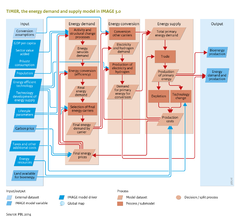Energy supply and demand: Difference between revisions
Jump to navigation
Jump to search
No edit summary |
No edit summary |
||
| Line 2: | Line 2: | ||
|ComponentCode=ESD | |ComponentCode=ESD | ||
|IMAGEComponent=Energy demand; Energy supply; Energy conversion; | |IMAGEComponent=Energy demand; Energy supply; Energy conversion; | ||
|ExternalModel=POLES model | |ExternalModel=POLES model; GCAM model | ||
|KeyReference=Van Vuuren, 2007; De Vries et al., 2001; | |KeyReference=Van Vuuren, 2007; De Vries et al., 2001; | ||
|Reference= | |Reference=Criqui et al., 2003; Thomson et al., 2011; | ||
|InputVar=GDP per capita; Sector value added; Private consumption; Population; Technology development of energy conversion; Technology development of energy supply; Lifestyle parameters; Carbon price; Energy resources; Land supply for bioenergy - grid; | |InputVar=GDP per capita; Sector value added; Private consumption; Population; Technology development of energy conversion; Technology development of energy supply; Lifestyle parameters; Carbon price; Energy resources; Land supply for bioenergy - grid; | ||
|Parameter=Conversion assumptions; Taxes and other additional costs; | |Parameter=Conversion assumptions; Taxes and other additional costs; | ||
Revision as of 11:22, 5 May 2014
|
Composition of Energy supply and demand Additional info |
| Component is implemented in: |
|
| Projects/Applications |
| Models/Databases |
| Key publications |
| References |
Description of Energy supply and demand
